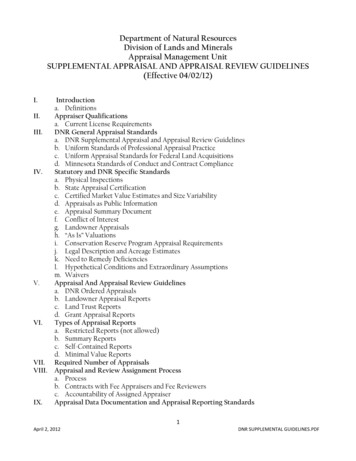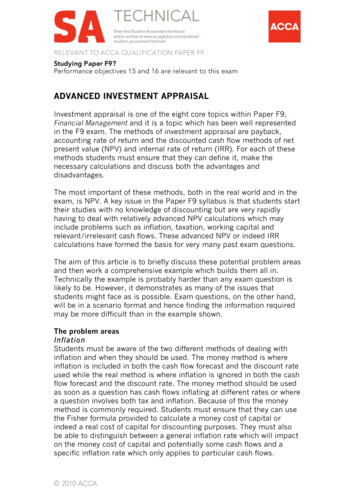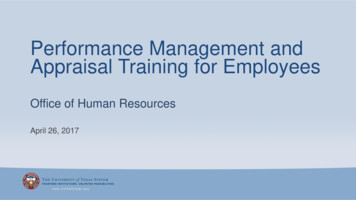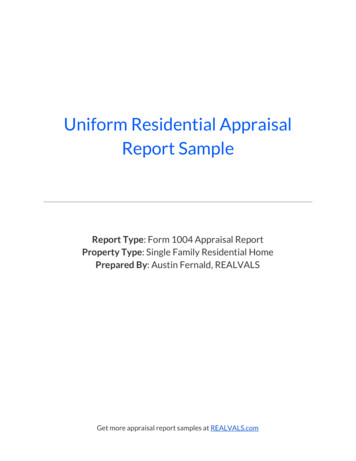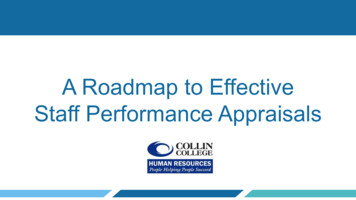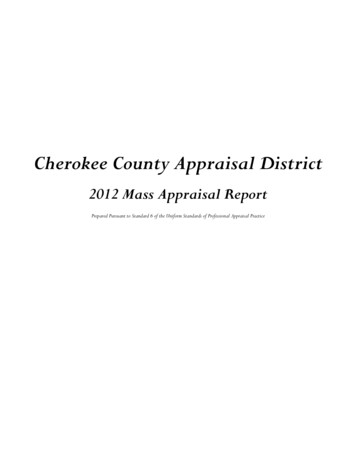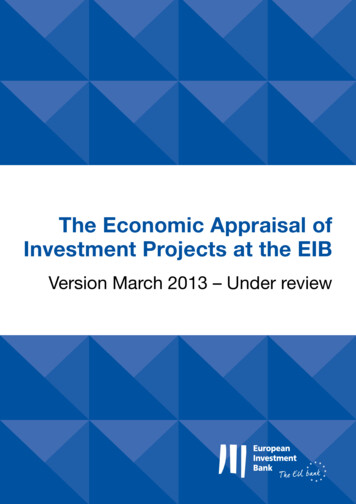
Transcription
The Economic Appraisal ofInvestment Projects at the EIBVersion March 2013 – Under review
European Investment BankThe Economic Appraisal of Investment Projects at the EIBThe Economic Appraisal ofInvestment Projects at the EIBProjects DirectorateMarch 2013(Under review)30/10/2020 – Note to the ReaderThe EIB Projects Directorate conducts technical and economic appraisal of the projectsfinanced by the Bank, and JASPERS includes economic appraisal in its project preparationassistance. Economic appraisal plays a central role in the operations of the EIB. It allows theBank to judge whether an investment project will contribute to the economic growth andcohesion of the EU and the economic progress of its partners.This guide, which was published in April 2013 in the EIB website, illustrates how the Bankconducts economic appraisal across the sectors of the economy where it operates.The transformation of the EIB into the EU Climate Bank, as well as research advances in someof the elements of the appraisal require that the guide be revised. Amongst some of theelements requiring revision there are: the cost of carbon, the value of time (VoT) in transportand the value of transport safety.This version under review provides links to updated documents for their use until thenew version of the guide is available by end of 2021 at the latest.30 October 2020page 1 / 211
European Investment BankThe Economic Appraisal of Investment Projects at the EIBTable of ContentsList of Abbreviations and Acronyms. 3Contributors . 6Foreword 81Introduction . 9PART 1: METHODOLOGY TOPICS: CROSS-SECTOR . 142Financial and Economic Appraisal . 153Defining the Counterfactual Scenario. 204Incorporating Environmental Externalities . 245Land Acquisition and Resettlement . 286Wider Economic Impacts . 317Economic Life and Residual Value. 418The Social Discount Rate . 449Multi-Criteria Analysis (MCA) . 5310Risk Analysis and Uncertainty . 66PART 2: METHODOLOGY TOPICS: SECTOR-SPECIFIC. 7211Security of Energy Supply . 7312The Value of Time in Transport . 7913The Value of Transport Safety . 8114Road Vehicle Operating Costs . 8215Traffic Categories in Transport . 8416Risk-Reduction Analysis in Water . 92PART 3: SECTOR METHODS AND CASES . 9717Education and Research . 9818Renewable Energy . 10619Electricity Network Infrastructure . 11020Energy Efficiency and District Heating . 11521Health . 11822Private Sector Research, Development and Innovation (RDI) . 12523Software RDI . 13224Research Infrastructure . 13725Manufacturing Capacity . 14226Telecommunications. 14627Biofuel Production . 15628Tourism . 16029Interurban Railways . 16530Roads . 17131Urban Public Transport. 17832Airports . 18233Seaports . 18634Regional and Urban Development . 18935Public Buildings . 19636Solid Waste Management . 20137Water and Wastewater . 20530 October 2020page 2 / 211
European Investment BankThe Economic Appraisal of Investment Projects at the EIBList of Abbreviations and TH:FTTx:GC:GHG:GJ:GMO:GDP:GSM:HEV:HGV:HR:HSPA :HV:IATA:ICE:ICT:IFI:ILUC:IM:IO:IP:IPPC:IRR:IT:30 October 2020Third generation (of mobile telecommunications technology)Africa, Caribbean and Pacific Mandate of the EIBAverage incremental costBenefit-cost (ratio)Behavioural generalised costBuilding Research Establishment Environmental Assessment MethodCapital asset pricing modelCost-benefit analysisCombined cycle gas turbineCost-effectiveness analysisConversion factorDried distiller grains and solublesDistrict heatingDigital subscriber lineEuropean CommissionEnergy efficiencyEnvironmental impact assessmentEuropean Investment Bank, or “the Bank”Economic internal rate of return (also referred to as ERR)Economic net present valueEuropean Patent OfficeEuropean Regional Development FundEconomic Road Infrastructure Appraisal ModelEnterprise resource planningEconomic rate of return (also referred to as EIRR)(EU) Emissions Trading SchemeEuropean UnionForeign direct investmentFacility for Euro-Mediterranean Investment and PartnershipFinancial internal rate of return (also referred to as FRR)Financial net present value(EU Research) Framework ProgrammeFinancial rate of return (also referred to as FIRR)Fibre to the homeFibre to the (home/building/curb)Generalised costGreenhouse gasGiga JouleGenetically modified foodsGross domestic productGlobal System for Mobile CommunicationsHybrid electric vehicleHeavy goods vehicleHuman resourcesEvolved high-speed package accessHeavy vehicle (transport context) or high voltage (energy context)International Air Transport AssociationInternal combustion engineInformation and communications technologiesInternational financial institutionIndirect land-use changeInfrastructure managerInput-outputIntellectual propertyIntegrated Pollution Prevention and ControlInternal rate of returnInformation technologypage 3 / 211
European Investment Wh:UGS:UMTS:UNWTO:VAT:VHV:VOC:VOT:VPD:WACC:W&S:30 October 2020The Economic Appraisal of Investment Projects at the EIBJoint Assistance to Support Projects in European Regionskilo VoltKilowatt-hourLevelised costLocal currency unitsLevelised cost of energyLiquefied natural gasLong-term evolutionLight vehicle (transport context) or low voltage (energy context)Mechanical biological treatmentMulti-criteria analysisMega litreMedium voltageMegavolt-ampereMegawattMegawatt-hourNet present costNet present valueOperating cash-flowOrganisation for Economic Co-operation and DevelopmentOperations and maintenanceOperating expenditureOperations Department of the EIBPersonal computerPlugged-in hybrid electric vehicleProjects Department of the EIBPublic-private partnershipPublic service obligationPresent valueResearch and developmentResearch, development and innovationResearch infrastructureRisk Management Department of the EIBReal option analysisReturn on invested capitalRailway undertakingSoftware as a serviceSmall and medium-sized enterprisesStated preferenceStructural programme loanSingle radio access networkSocial time preference rateShip to shoreSolid wasteSolid waste managementTrack access chargeTwenty feet equivalent (container) unitTransmission system operatorTime to marketTerawatt-hourUnderground gas storageUniversal mobile telecommunications systemUnited Nations World Tourism Organisation (UNWTO)Value-added taxVery high voltageVehicle operating costsValue of timeVehicles per dayWeighted average cost of capitalWater and sanitationpage 4 / 211
European Investment BankWHO:WOP:WP:WTO:WTE:WTP:WWTP:30 October 2020The Economic Appraisal of Investment Projects at the EIBWorld Health OrganisationWithout projectWith projectWorld Trade OrganisationWaste to energyWillingness to payWastewater treatment plantpage 5 / 211
European Investment BankThe Economic Appraisal of Investment Projects at the EIBContributorsThis guide was prepared by EIB staff members involved in project appraisal and economicanalysis, as detailed below.The authors benefited from the advice of a panel of external academic advisors, comprisingProf. Martin Buxton (University of Brunel), Prof. Ginés de Rus (Universities of Las Palmas andCarlos III), Prof. Georg Erdmann (Technical University of Berlin), Prof. Per-Olov Johansson(Stockholm School of Economics), and Prof. Reinhilde Veugelers (University of Louvain). Therole of the panel was purely advisory, and no errors or omissions should be attributed to itsmembers.The authors of the document were the following:Coordinator and introductory chapter:J. Doramas Jorge-CalderónPart 1: Methodology topics – cross-sectorFinancial and economic appraisal:Defining the counterfactual scenario:Environmental externalities:Land take and resettlement:Wider economic impacts:Economic life and residual value:The social discount rate:Multi-criteria analysis:Risk analysis and uncertainty:Harald Gruber and Pierre-Etienne BouchaudJ. Doramas Jorge-CalderónEdward CalthropEdward CalthropEdward CalthropDiego FerrerArmin D. RiessChristine BladesJ. Doramas Jorge-CalderónPart 2: Methodology topics – sector-specificSecurity of energy supply:Value of time in transport:Value of transport safety:Road vehicle operating costs:Traffic categories in transport:Risk reduction analysis in water:Nicola PochettinoDiego Ferrer and Claus EberhardClaus Eberhard and Diego FerrerPierre-Etienne BouchaudJ. Doramas Jorge-CalderónThomas van GilstPart 3 – Sector methods and casesEducation and research:Heikki KokkalaPower generation:Renewable energy:Electricity network infrastructure:Gas grids, terminals and storage:Energy Efficiency and district heating:Jochen HierlDavid Kerins and Juan AlarioJochen HierlNicola PochettinoDavid Kerins and Juan AlarioHealth:Christine BladesPrivate sector RDI:Software RDI:Research infrastructure:Manufacturing capacity:Antonello Locci and Tom AndersenAnders BohlinJacques Van Der MeerTom AndersenTelecommunications:Jussi HätönenBiofuel production:Tourism:Oliver HennigesCampbell ThomsonInterurban railways:Alfredo Díaz30 October 2020page 6 / 211
European Investment BankThe Economic Appraisal of Investment Projects at the EIBRoads:Urban public transport:Airports:Seaports:Pierre-Etienne BouchaudMauro RavasioJ. Doramas Jorge-CalderónJ. Manuel Fernández RiveiroRegional and urban development:Public buildings:Sebastian Hyzyk and Brian FieldLourdes Llorens, Mariana Ruiz and Brian FieldSolid waste management:Water and wastewater:Patrick DorvilThomas van Gilst and Monica ScatastaThe authors are grateful to colleagues who reviewed earlier drafts of the guide, including AnnLouise Aktiv Vimont, Edward Calthrop, Harald Gruber, Armin D. Riess and Timo Välilä. Thanksalso to colleagues who assumed coordinating roles within particular sectors, including BrianField, Harald Gruber, Jochen Hierl, and J. Doramas Jorge-Calderón, as well as to colleagueswho coordinated input from JASPERS, including Antonio Almagro, Alan Lynch, Tudor Raduand Pasquale Staffini. José Luís Alfaro kindly commented on parts of the guide. Finally, theauthors thank Stéphanie Marion for assistance during the preparation and formatting of thedocument and Mirjam Larsson for assistance with the preparation of tables.30 October 2020page 7 / 211
European Investment BankThe Economic Appraisal of Investment Projects at the EIBForewordThe EIB Projects Directorate conducts technical and economic appraisal of the projectsfinanced by the Bank, and JASPERS includes economic appraisal in its project preparationassistance. Economic appraisal thus plays a central role in the operations of the EIB. It allowsthe Bank to judge whether an investment project will contribute to the economic growth andcohesion of the EU and the economic progress of its partners.Some projects have poor financial performance, and therefore may not be financed by theprivate sector at reasonable terms, or at all. Private sector investors evaluate projects usingstandard financial appraisals that focus on private financial returns. Economic appraisal, inturn, takes a broader view to include other benefits and costs to society, accounting for allresources used by the project, whether human, technological, or natural, and gauges the valuethe project generates to all stakeholders, to determine whether society at large gains from theinvestment.The economic viability of a project can be seen as synonymous with sustainability, cohesionand growth in many respects. A project that is economically viable generates products orservices that are valued by society and that may contribute to improving productivity and growthfor the economy. Any employment generated by an economically sound project would involvejobs that are sustainable over the long run. By accounting for environmental costs and benefits,economic appraisal sees that any impact on the environment is not gratuitous, while giving fullcredit to the benefits of environmentally efficient technologies. Finally, economic appraisalensures that any financial support by the government or from European funds to a viable projectis public money well spent.This guide illustrates how the Bank conducts economic appraisal across all the sectors of theeconomy where it operates. The Bank uses standard economic appraisal techniques, includingCost-Benefit Analysis, Cost-Effectiveness Analysis and, more recently, Multi-Criteria Analysis,taking into account the evolving circumstances of each sector. Indeed, economic appraisal isnot a static discipline. The development of new sectors and technologies, and theadvancement of techniques and publication of new findings by academia, require that themethodologies and parameters used in project appraisal evolve. For this reason, the Bankcontinuously engages in revisions of methodologies and updates key variables used inappraisals, most often in cooperation with academia and other consultants, as will becomeapparent to the reader.Given the wide range of sectors, the treatment of each in the guide is necessarily schematic.Still, by combining discussions of the application of techniques to each sector with case studies,the document provides a comprehensive picture of appraisal practice in the Bank. Methodologythemes of particular interest are treated separately in more detail and, whereas the guide isintended for as wide an audience as possible, technical precision is provided where needed forthe benefit of the specialist reader.The guide should allow the reader to gain a thorough understanding of how the EIB looksbeyond commercial considerations to ensure that investment projects are supported for theircontribution to cohesion, employment, growth and sustainability of the EU and its partners.Christopher HurstDirector General, Projects Directorate30 October 2020page 8 / 211
European Investment BankThe Economic Appraisal of Investment Projects at the EIB1 IntroductionJ. Doramas Jorge-Calderón 11.1Objective of the guideThis document presents the economic appraisal methods that the EIB (the Bank) uses in orderto assess the economic viability of projects. It is not intended as a manual, nor is it meant toinstruct the reader about how to conduct the economic appraisal of a project – a “how to do it”guide – as there are already many textbooks and guides widely available. 2 Likewise, the aimhere is not to review the theory behind economic appraisal, as many widely available referencesare suitable for that purpose. Rather, this guide describes “how the EIB does it,” giving thegeneral reader an overview of the methods used, and the specialist a guide to the applicationof analytical tools across sectors by the Bank.The document has been written by EIB economists working on project appraisal. There arenearly 30 authors, each of them writing on their areas of specialisation. Economic appraisal isan ever-evolving field, and individual contributors have identified areas where there is ongoingwork to update parameters or revise methods. This is thus a snapshot of economic appraisalpractice at the time of writing and lends itself to updates over time.It is also worth underlining that the guide covers economic appraisal only. The overall appraisalof a project by the Projects Directorate also involves technical, environmental and procurementaspects. More broadly, every Bank operation also involves credit and legal assessments.This introductory chapter goes on to present the case for economic appraisal, whichcomplements financial appraisal in measuring the returns of a project to society. It thendescribes how the conditions under which the Bank operates shape the type of appraisalsuitable for providing the answer the Bank’s governing bodies require to help them channelfinancing to projects that fulfil the Bank’s objectives. It finishes by making a general introductionto the structure of the guide.1.2The need for economic appraisalIn competitive, undistorted markets with well-defined property rights, the revenues generatedby an investment project measure the value that the output of the project generates for its users,and the money costs of the project measure the value (or opportunity cost) of resources usedin producing the output. In other words, prices for inputs and outputs are valid measures ofvalue and scarcity. In addition, since projects tend to be marginal in relation to the size of theeconomy at large, they do not affect prices more than marginally, and hence there is no needto make additional considerations about consumer or producer surplus. Under suchcircumstances, the financial return on capital of the project would be a necessary and sufficientindicator to determine whether the project is worth undertaking or not from the social welfarepoint of view.However, markets are not always sufficiently competitive, prices are often distorted, andproperty rights are at times not well defined, leaving externalities with no price assigned tothem. For these reasons, a project’s financial return may not be an adequate indicator for thedesirability of the project for society at large. At times, as in some public goods, a financialThis introduction builds partly on the note to the Board of Directors of 2008 “The Economic Appraisal of Projects: AnOverview of the Approach within the Bank” 08/580 prepared by J. Doramas Jorge-Calderón and Edward Calthrop withthe cooperation of all PJ departments.2The DG Regio Guide to Cost-Benefit Analysis has such a pedagogic element. In addition, it sets the principles thatapplicants for European Cohesion Fund financing must follow in their preparation of CBAs, adding an element of “howwe want it done.” See European Commission (2008) Guide to Cost Benefit Analysis of Investment Projects. EuropeanCommission Directorate General Regional Policy: Brussels. Available at:http://ec.europa.eu/regional policy/information/evaluations/guidance en.cfm#5130 October 2020page 9 / 211
European Investment BankThe Economic Appraisal of Investment Projects at the EIBreturn may not exist at all. Provision of public goods may be made free of charge to the userand generate no revenues to the investor, such as a dyke to preserve an eroding beach.The standard economic appraisal technique, which helps assess the socio-economicdesirability of the project, is cost-benefit analysis (CBA). It is designed to produce a measureof project returns corrected for the various distortions and constraints to markets mentionedabove.CBA has a long tradition within Europe. Its origin as a discipline is attributed to a Frenchengineer, Jules Dupuit (1848), before being developed by economists. It has become astandard part of public decision-making in many Member States, notably as a means to justifythe use of public funds. At the European level, projects that apply for grant funding from theEuropean Commission are required to present an economic justification – in 2008 DG Regioupdated an appraisal manual to help promoters and consultants to provide robust analysis (seefootnote 2). In addition to the EIB, many other International Financial Institutions (IFIs) andinternational organisations also appraise projects’ economic desirability.The outcome of a CBA is summarised in two complementary figures – the economic rate ofreturn (ERR) and the economic net present value (ENPV). The ERR of a project is the averageannual return to society on the capital invested over the entire life of the project. It is, in otherwords, the interest rate at which the project’s discounted benefits equal discounted costs, bothvalued from the entire society’s point of view. A project is accepted if the ERR is equal to orexceeds a certain threshold (the social discount rate). The ENPV of a project is the differencebetween discounted benefits and costs at a given discount rate. The correct discount rateequals the threshold rate just mentioned. Projects are accepted if the ENPV is positive.Despite this seemingly schematic way of applying CBA, it is worth emphasising that economicappraisal by means of CBA is more than just a mechanical exercise. Good analysis can helpclarify the aim of the project; estimate what will happen if the project is undertaken, and whatwill happen if it is not; evaluate whether the proposed project is the best option available; identifywhether components of the project are the most efficient; identify who wins and who loses fromthe project; quantify the overall impact on government’s fiscal position; evaluate whether theproject is financially sustainable; evaluate the risks in the project; and – ultimately – provide aninformed view to decision-makers as to whether the project is worthwhile for society.CBA measures the difference between the flow of costs and benefits with the project and thosewithout (the "with project" and "without project" scenario). Policy choices are rarely between aproject and no project – rather, there are usually several plausible policy alternatives (e.g. theconstruction of a new greenfield motorway for 100km, or greenfield for the first 50km only, withupgrading of existing road for remainder, or upgrading existing road for the entire length).Economic analysis will typically compare several policy scenarios against a common “withoutproject” baseline. Moreover, as infrastructure and other capital assets typically have long lives,these different scenarios must measure flows over many years.Depending on the nature of the alternatives to be assessed, and the type of data available, acomprehensive CBA may not be possible. In such cases, the CBA may be replaced by a costeffectiveness analysis (CEA, focusing on the cost of attaining a given target) or perhaps a multicriteria analysis (MCA). These alternatives are not necessarily substitutes for each other andmay well be seen as complementary to full CBA, particularly if economic viability is to beweighed with other policy considerations. However, as discussed below, the Bank makes adiscrete choice among the methodologies, applying CBA where feasible, CEA where the projectfocuses on choice of technology, and MCA where the other methods are deemed impractical.Much depends on the extent to which output variables, and benefits in particular, can bemeasured and monetised. There are cases where benefits are hard to quantify, in which casea traditional CBA cannot be applied, and a cost-effectiveness analysis becomes moreappropriate. In such cases the decision to carry out a certain type of investment or program isdetermined as part of the political process and a cost-effectiveness analysis is used todetermine the best project to achieve the desired results, generally the one that achieves thegreatest output per unit of input.30 October 2020page 10 / 211
European Investment BankThe Economic Appraisal of Investment Projects at the EIBMCA, in turn, consists of combining various evaluation techniques addressing different criteria,and applying weightings to each of them in order to arrive to a single score used to comparealternative projects. Typical criteria would include affordability tests, income distributionconsiderations, compliance with strategic objectives, quality of the internal decision-making ofthe promoter, visual appeal, etc.In general, the suitability of the three techniques to project circumstances can be summarisedas in Table 1.1. The two drivers are the extent to which the output variables can be measured(and monetised) and the degree to which the project produces multiple outputs.Table 1.1:Suitability of methodologies across project circumstancesNumber of output variablesDegree to whichoutput variables canbe easily measuredand monetisedHighLowHighCBACEACBACEALowMCACEAThe aim of all three techniques is to go beyond financial flows, and to correct for distortions thatmay be present in markets, to reflect wider benefits and costs to society, in order to assess theviability of the project to meet society’s needs.1.3Economic appraisal at the EIBThe Bank finances projects in a very broad range of sectors, essentially covering all industrieswith the exception of only a few. Sectors include competitive industries, oligopolies and naturalmonopolies, as well as public goods. The outputs produced include both manufactured goodsand services. The latter case includes, among others, basic services where consumer surplusmay be impracticable to measure, for reasons that will become apparent in the sectorpresentations.Such variety implies that the Bank must use an array of methodologies rather than a single,homogeneous one. In the Bank, about half of project appraisals rely on ERR calculations, andthe other half on other methods. This variety means that the results of studies across sectorsare not always directly comparable. Nonetheless, it is necessary for them to be compatible andconsistent, meaning that the application of alternative methodologies to projects, wherefeasible, would yield the same decision as to the suitability for Bank financing.1.3.1Context of Bank appraisalsThe previous section provided an overview of the role economic appraisal can play in informingpolitical choice on the socio-economic value of a project. This is of primary benefit to nationalauthorities themselves, not least in justifying the use of public funds to taxpayers. This type ofappraisal is most useful when performed early in the project cycle, when very different possiblecourses of action may be taken (e.g. fossil-fuel versus renewable energy; high-speed rail versusupgrade to conventional rail system etc.). Indeed, in many Member States, economic appraisalis a sizeable industry in itself. A large project may require something in the order of five to tenperson-years in consultancy work, developing models, collecting data, analysing differentscenarios. In some sectors, such as road transport, economic appraisal is often undertaken byBank services on the basis of an economic feasibility study provided by the project promoter.30 October 2020page 11 / 211
European Investment BankThe Economic Appraisal of Investment Projects at the EIBIn other sectors the Bank’s services must normally construct the economic appraisal fromscratch, on the basis of business plans and financial projections.If the promoter has produced an economic appraisal, and if the promoter’s studies were ofconsistent high quality, the services review and summarise the available material and theirsuitability for decision-making. In practice, however, there are several possible problems thatmay be encountered when discussing the eco
European Investment Bank The Economic Appraisal of Investment Projects at the EIB 30 October 2020 page 1 / 211 . The Economic Appraisal of . Investment Projects at the EIB . Projects Directorate . March 2013 (Under review) 30/10/2020 - Note to the Reader . The EIB Projects Directorate conducts technical and economic appraisal of the projects


